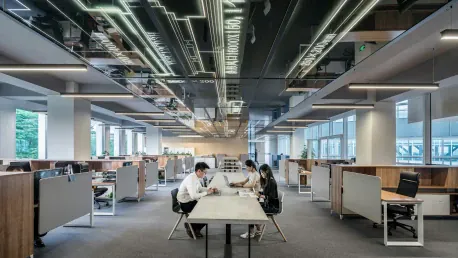Predictive maintenance (PdM) has emerged as a cornerstone in the management of smart buildings, ensuring operational efficiency and longevity of building systems. It relies on advanced technologies like artificial intelligence (AI) and IoT sensors to predict potential failures and schedule maintenance before any actual problems occur. However, several challenges can undermine its success if not addressed proactively. Understanding these pitfalls and implementing solutions can significantly enhance the effectiveness of PdM, contributing to the seamless operation of smart building technologies.
The Importance of Data Quality
Accurate, reliable data is the linchpin of any AI-driven PdM system, and its importance cannot be overstated. The predictions and recommendations generated by these systems are only as good as the data fed into them. One significant risk to PdM efficiency is the presence of bad data. Inaccurate, incomplete, or redundant data can lead to incorrect predictions, causing unnecessary maintenance or missing faults altogether. This phenomenon, known as AI hallucinations, occurs when the AI makes unreliable decisions based on flawed data inputs.
To combat this, building owners must prioritize regular data maintenance and calibration. Ensuring that data is accurate and well-curated will help in making reliable maintenance decisions and avoiding costly mistakes. Additionally, implementing robust data validation processes at the point of data entry can prevent the introduction of errors, ensuring that only high-quality data enters the system. By doing so, it becomes possible to maximize the reliability and precision of PdM operations, ultimately enhancing building performance and reducing operational costs.
Furthermore, it is crucial to foster a data-centric culture within the organization. Training staff on the importance of data quality and empowering them with the tools to monitor and adjust data sets can significantly reduce the risk of errors. Regular audits and reviews of data sources should be conducted to identify and rectify any potential issues. This proactive approach ensures that PdM frameworks are continuously fed with high-quality data, enabling AI systems to perform optimally and deliver accurate predictions.
Challenges of Low-Quality Technology
The rapid expansion of the smart building technology market has introduced a plethora of new, more affordable tech options, creating a tempting scenario for building owners looking to minimize initial investments. Nevertheless, not all technology is created equal. Low-quality IoT sensors and poorly integrated software are common culprits behind inaccurate or insufficient data collection, which can significantly hinder PdM efforts. The temptation of inexpensive alternatives often backfires, resulting in higher long-term costs due to ineffective maintenance schedules and increased incidences of equipment failure.
Despite these challenges, there are ways to salvage and even improve investments in low-quality technology. Building owners can tune current solutions based on vendor recommendations, add third-party tools, or negotiate with vendors for additional support or upgrades to improve the accuracy and reliability of PdM predictions. Leveraging supplementary software tools that can enhance data accuracy and integrating them into existing frameworks can help bridge the gap created by substandard technology.
Furthermore, it is important to establish rigorous benchmarking processes to evaluate and improve the performance of IoT devices and software used in PdM systems. By continually assessing the effectiveness and reliability of technology, building owners can ensure that their PdM systems remain efficient and effective. Regular maintenance and updates to these systems, carried out in collaboration with technology vendors, can also mitigate the negative impacts of low-quality tech, resulting in more accurate and actionable PdM predictions.
Enhancing Cybersecurity for Reliable PdM
In the realm of smart buildings, cybersecurity is an increasingly critical concern, as breaches can severely disrupt PdM activities. Compromised operational technology (OT) and IoT systems not only lead to data integrity issues but can also result in inaccessible or unreliable data streams. Such vulnerabilities pose significant threats, undermining the reliability of PdM systems and potentially causing considerable operational disruptions.
Strong cybersecurity measures are essential to protect PdM frameworks from potential threats. This includes network segmentation to isolate critical systems from general networks, employing anomaly detection tools to monitor unusual traffic patterns, encrypting sensitive data, and automating patch management to keep systems secure. By implementing these measures, building owners can substantially reduce the risk of cyberattacks and ensure the continuous, reliable operation of their PdM systems.
Moreover, it is imperative to establish a comprehensive cybersecurity strategy that includes regular penetration testing and vulnerability assessments. These practices enable organizations to identify and address weaknesses in their systems proactively. Creating an incident response plan that outlines the steps to be taken in the event of a breach ensures that the damage can be contained and rectified swiftly, minimizing downtime and preserving data integrity.
Training staff to recognize and respond to cybersecurity threats is another vital component of maintaining secure PdM systems. Employee awareness programs and regular cybersecurity drills can empower staff to act swiftly and effectively in the face of potential breaches. By bolstering cybersecurity, building owners can ensure that PdM systems function reliably, with data integrity maintained at all times, ultimately transforming predictive maintenance into a robust cornerstone of smart building operations.
Strategies for Maximizing Predictive Maintenance Efficiency
Given the critical role of predictive maintenance in smart building operations, it is essential to implement strategies that maximize its efficiency. One such strategy involves the continuous integration and updating of AI algorithms to adapt to changing data patterns and operational needs. AI systems must evolve to accommodate new data inputs and learning from past maintenance activities to refine their predictive capabilities. Regularly updating these algorithms ensures that PdM systems remain responsive and accurate in forecasting potential failures.
Additionally, the collaboration between building owners, technology vendors, and maintenance personnel is vital. Effective communication and sharing of insights between these stakeholders can lead to more informed decisions and streamlined maintenance processes. For instance, maintenance teams can provide valuable feedback on the accuracy of AI predictions, enabling technology vendors to refine their algorithms and improve PdM systems.
Investing in comprehensive training programs for staff involved in PdM activities is another crucial strategy. These programs should cover the latest advancements in AI technology, data management practices, and cybersecurity protocols. Equipping staff with advanced skills ensures that they can effectively manage and respond to the nuances of PdM systems, further enhancing accuracy and reliability.
Conclusion: Future Considerations for PdM in Smart Buildings
Predictive maintenance (PdM) has become essential for managing smart buildings, ensuring both operational efficiency and the longevity of building systems. Utilizing advanced technologies such as artificial intelligence (AI) and Internet of Things (IoT) sensors, PdM can foresee potential failures and schedule necessary maintenance before real issues arise. However, several challenges can jeopardize its effectiveness if not addressed promptly. Common pitfalls can include lack of data accuracy, inadequate staff training, and cost concerns, potentially undermining PdM’s benefits. By proactively understanding and addressing these challenges, the implementation of PdM can significantly enhance the smooth operation of smart building technologies. This ensures that systems remain efficient and reliability is maintained, ultimately contributing to the overall effectiveness and functionality of smart buildings.









